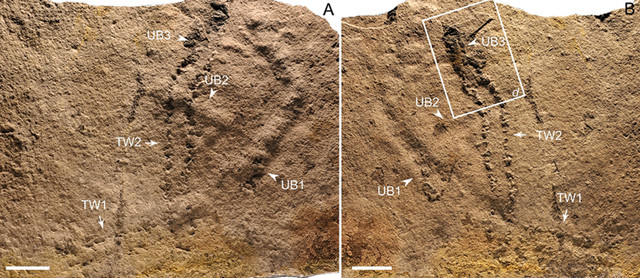
by Lucas Joel Monday, September 10, 2018

These fossil trackways from China bear Earth's first "footprints" — the dimple-like bumps that make up each trackway. Credit: NIGP.
As far as we know, life originated on Earth about 3.5 billion years ago, and for roughly the first 3 billion years of that history all life was microscopic. Then, during the Ediacaran Period from 635 million to 541 million years ago, the first organisms visible to the naked eye emerged. Although many members of this group, called the Ediacara biota, would have looked alien to us, some nonetheless had features we might find familiar. And according to a new study, it was Ediacaran creatures that left behind Earth’s oldest-known footprints.
Researchers working in China discovered rocks bearing trackways of a creature that scurried over the ancient seafloor. “The main finding is potential trace fossil evidence for the presence of paired appendages,” says Shuhai Xiao, a paleontologist at Virginia Tech and a co-author of the new study in Science Advances. The trackways, which resemble two parallel bicycle tracks snaking through the mud, are marked by dimples along their lengths. These dimples, Xiao and his colleagues think, are impressions from “paired appendages” — that is, matching appendages on either side of the body, as suggested by the parallel trackways — that the ancient animal used to move about.
Paleontologists have known that certain members of Ediacara biota were able to move freely about in their environments; trace fossil burrows preserved in rocks in places like South Australia attest to this. However, this is the first evidence for appendages in the group. “Paired appendages are functionally and ecologically important,” Xiao says. “They are the evolutionary basis of legs, limbs, wings and many other functionally diverse anatomical structures.”
© 2008-2021. All rights reserved. Any copying, redistribution or retransmission of any of the contents of this service without the expressed written permission of the American Geosciences Institute is expressly prohibited. Click here for all copyright requests.